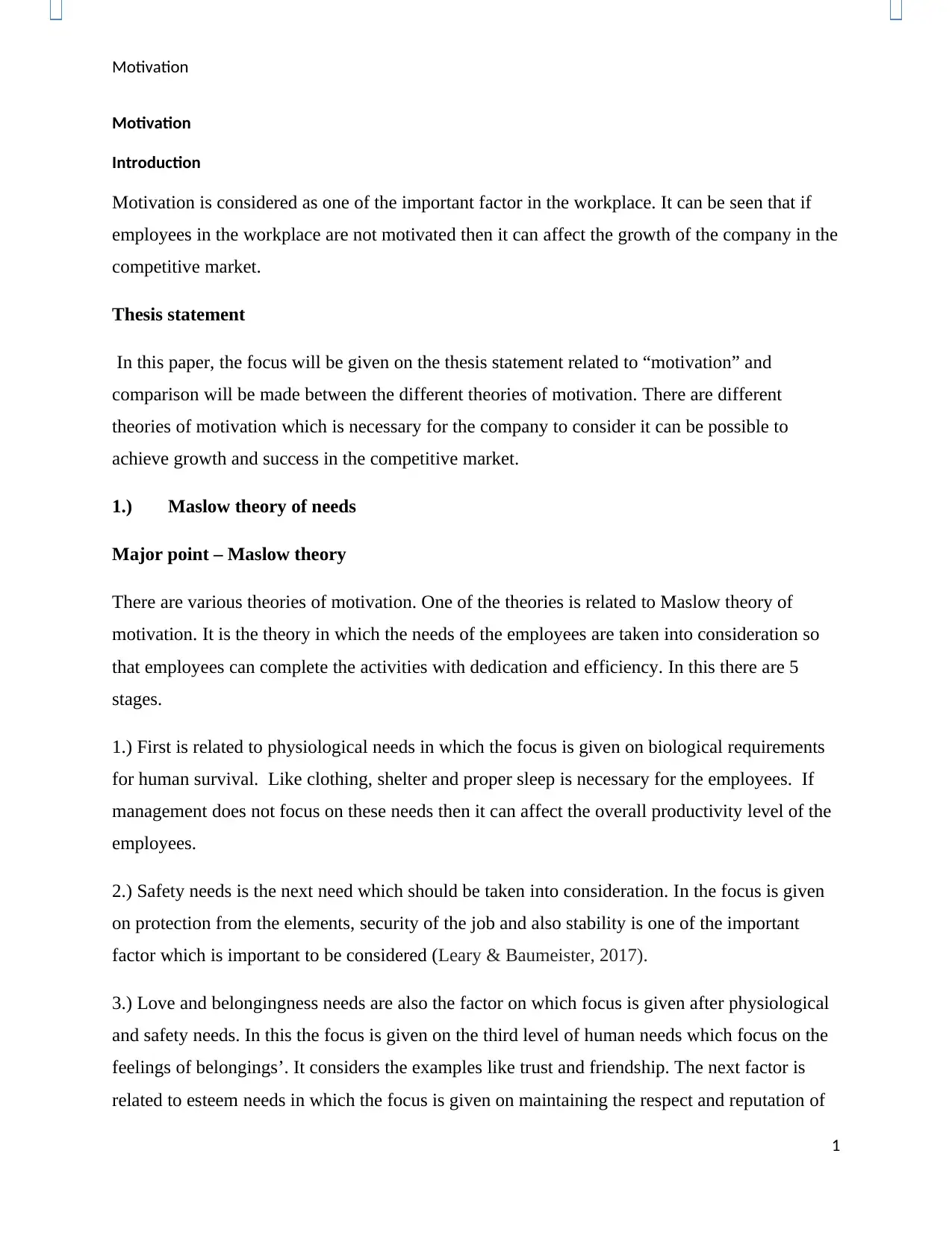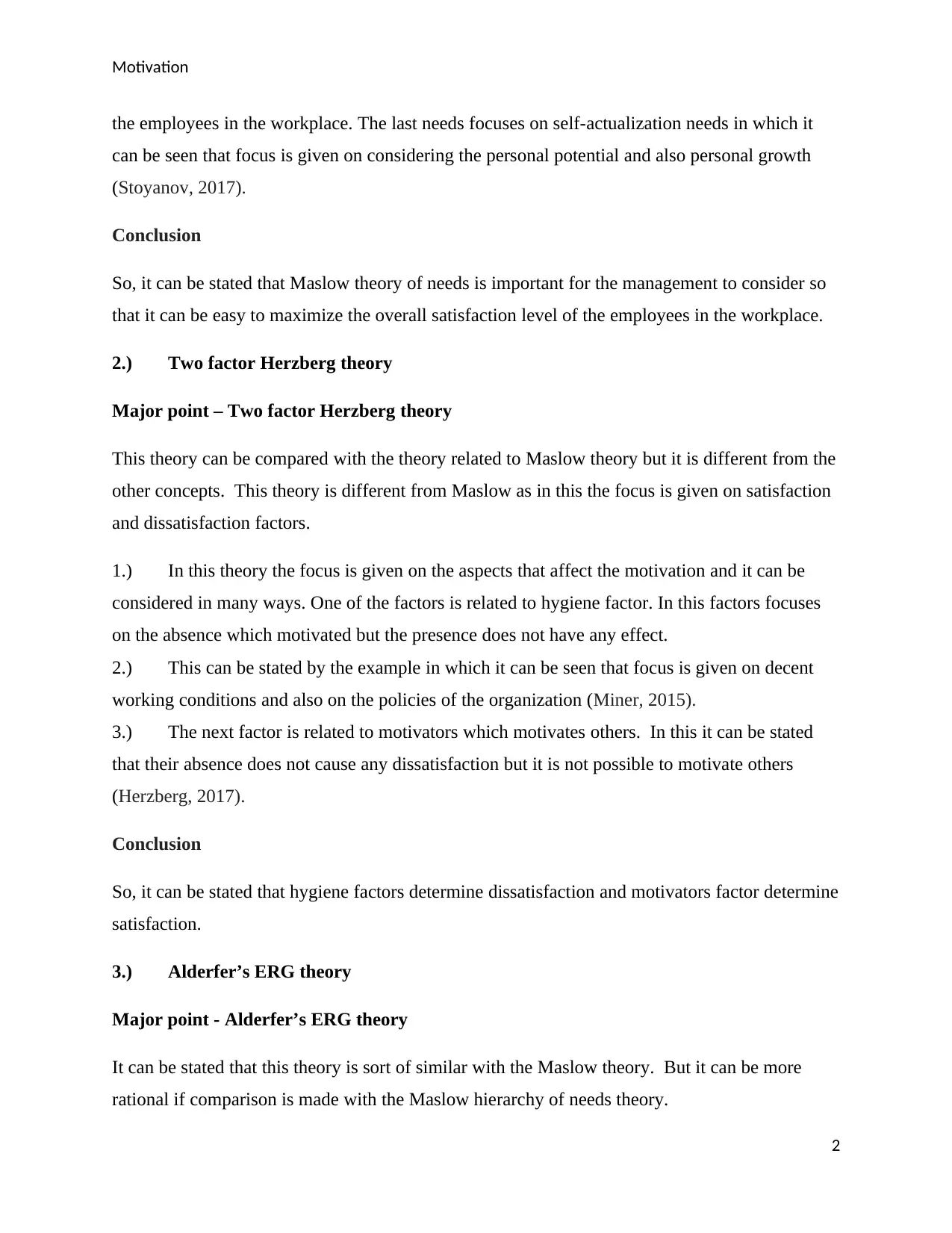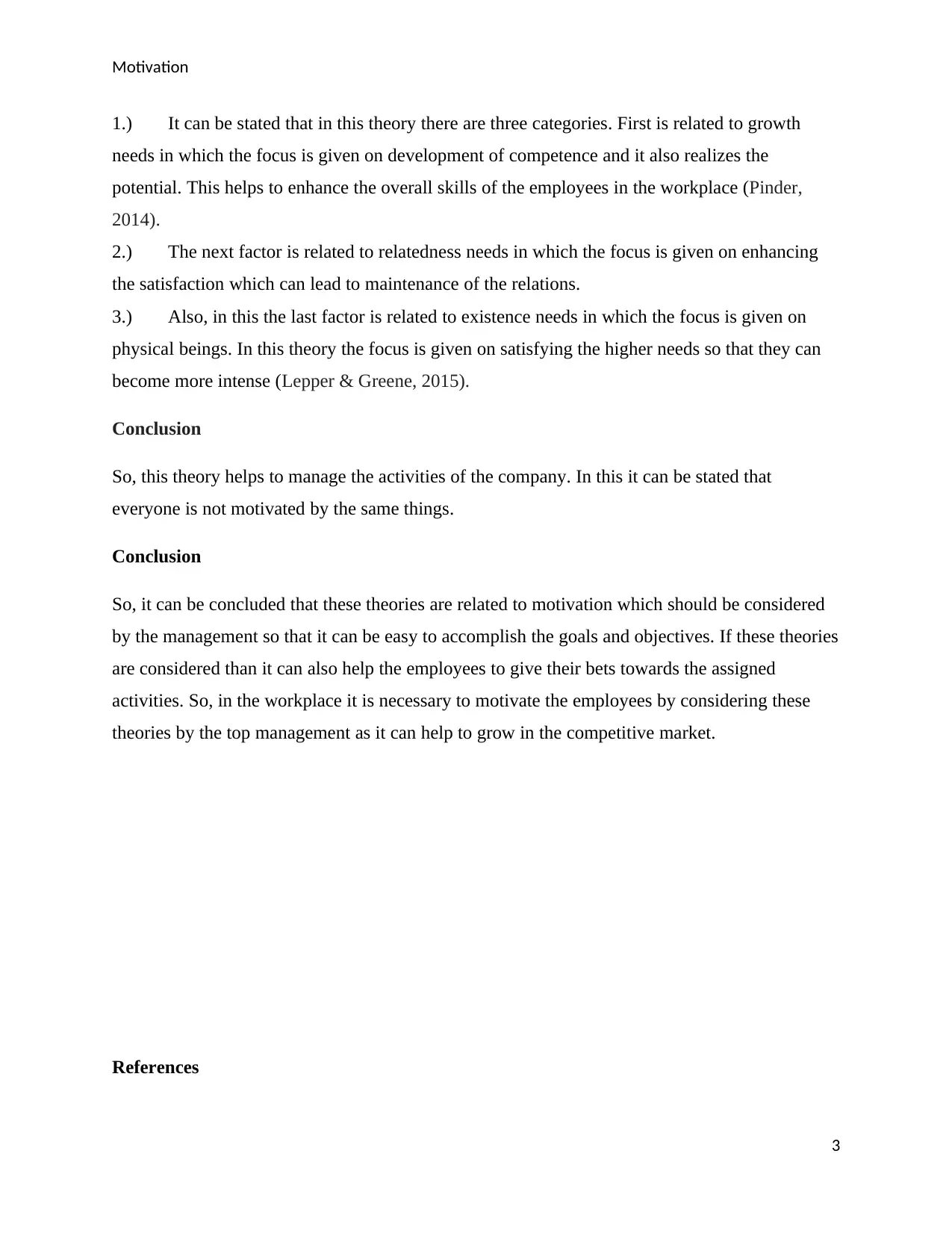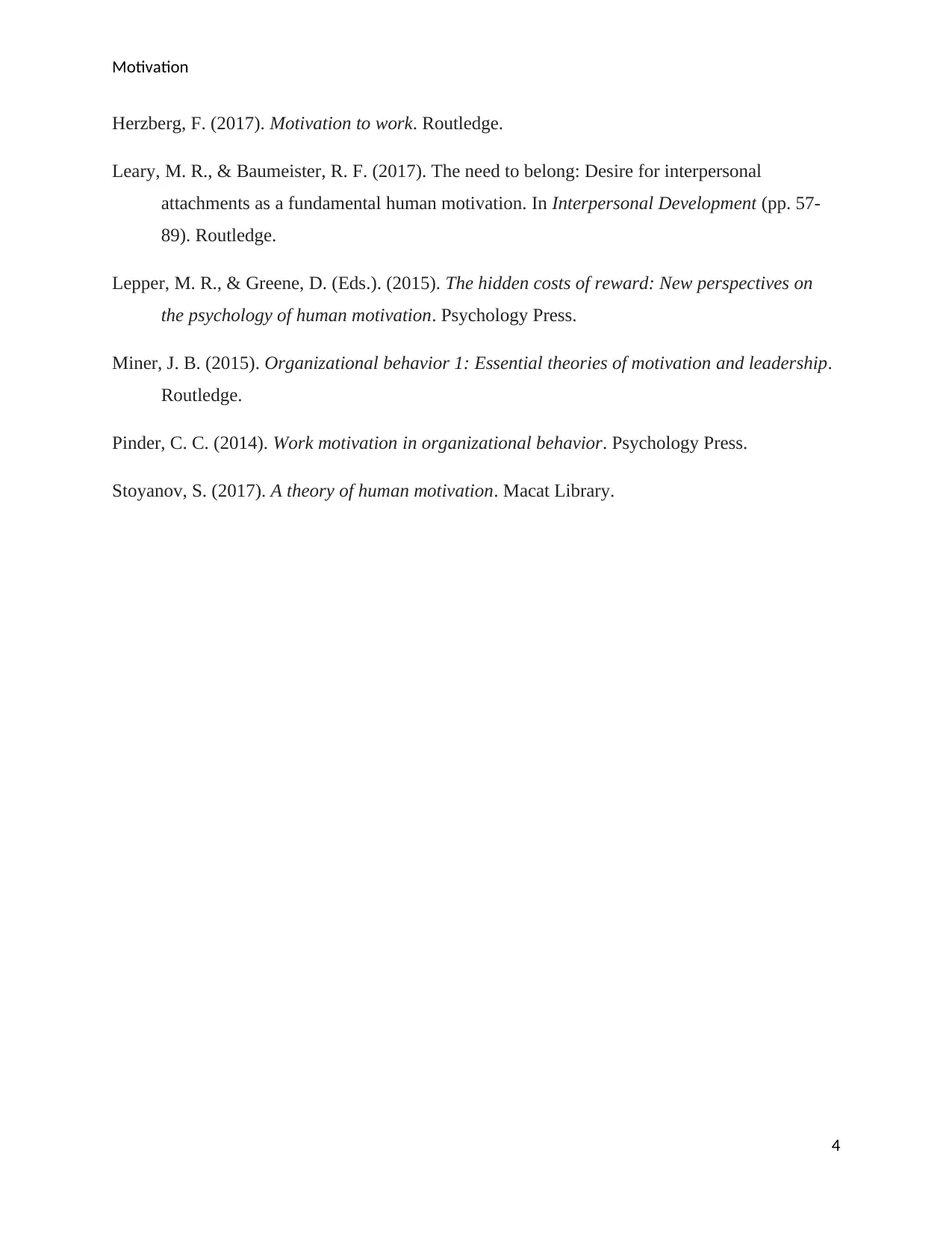Comparative Analysis of Motivation Theories in the Workplace
VerifiedAdded on 2021/10/31
|5
|1061
|24
Essay
AI Summary
This essay provides a comparative analysis of prominent motivation theories relevant to the workplace. It begins by introducing the concept of motivation and its significance in fostering company growth within a competitive market. The essay then delves into three key theories: Maslow's hierarchy of needs, Herzberg's two-factor theory, and Alderfer's ERG theory. For Maslow's theory, the essay explains the five stages of needs, from physiological to self-actualization, and their impact on employee satisfaction. It then contrasts this with Herzberg's theory, focusing on hygiene factors and motivators. Finally, the essay discusses Alderfer's ERG theory, highlighting its similarities to Maslow's but with a focus on existence, relatedness, and growth needs. The conclusion emphasizes the importance of considering these theories to maximize employee satisfaction and achieve organizational goals.

Academic Essay
Paraphrase This Document
Need a fresh take? Get an instant paraphrase of this document with our AI Paraphraser

Motivation
Motivation
Introduction
Motivation is considered as one of the important factor in the workplace. It can be seen that if
employees in the workplace are not motivated then it can affect the growth of the company in the
competitive market.
Thesis statement
In this paper, the focus will be given on the thesis statement related to “motivation” and
comparison will be made between the different theories of motivation. There are different
theories of motivation which is necessary for the company to consider it can be possible to
achieve growth and success in the competitive market.
1.) Maslow theory of needs
Major point – Maslow theory
There are various theories of motivation. One of the theories is related to Maslow theory of
motivation. It is the theory in which the needs of the employees are taken into consideration so
that employees can complete the activities with dedication and efficiency. In this there are 5
stages.
1.) First is related to physiological needs in which the focus is given on biological requirements
for human survival. Like clothing, shelter and proper sleep is necessary for the employees. If
management does not focus on these needs then it can affect the overall productivity level of the
employees.
2.) Safety needs is the next need which should be taken into consideration. In the focus is given
on protection from the elements, security of the job and also stability is one of the important
factor which is important to be considered (Leary & Baumeister, 2017).
3.) Love and belongingness needs are also the factor on which focus is given after physiological
and safety needs. In this the focus is given on the third level of human needs which focus on the
feelings of belongings’. It considers the examples like trust and friendship. The next factor is
related to esteem needs in which the focus is given on maintaining the respect and reputation of
1
Motivation
Introduction
Motivation is considered as one of the important factor in the workplace. It can be seen that if
employees in the workplace are not motivated then it can affect the growth of the company in the
competitive market.
Thesis statement
In this paper, the focus will be given on the thesis statement related to “motivation” and
comparison will be made between the different theories of motivation. There are different
theories of motivation which is necessary for the company to consider it can be possible to
achieve growth and success in the competitive market.
1.) Maslow theory of needs
Major point – Maslow theory
There are various theories of motivation. One of the theories is related to Maslow theory of
motivation. It is the theory in which the needs of the employees are taken into consideration so
that employees can complete the activities with dedication and efficiency. In this there are 5
stages.
1.) First is related to physiological needs in which the focus is given on biological requirements
for human survival. Like clothing, shelter and proper sleep is necessary for the employees. If
management does not focus on these needs then it can affect the overall productivity level of the
employees.
2.) Safety needs is the next need which should be taken into consideration. In the focus is given
on protection from the elements, security of the job and also stability is one of the important
factor which is important to be considered (Leary & Baumeister, 2017).
3.) Love and belongingness needs are also the factor on which focus is given after physiological
and safety needs. In this the focus is given on the third level of human needs which focus on the
feelings of belongings’. It considers the examples like trust and friendship. The next factor is
related to esteem needs in which the focus is given on maintaining the respect and reputation of
1

Motivation
the employees in the workplace. The last needs focuses on self-actualization needs in which it
can be seen that focus is given on considering the personal potential and also personal growth
(Stoyanov, 2017).
Conclusion
So, it can be stated that Maslow theory of needs is important for the management to consider so
that it can be easy to maximize the overall satisfaction level of the employees in the workplace.
2.) Two factor Herzberg theory
Major point – Two factor Herzberg theory
This theory can be compared with the theory related to Maslow theory but it is different from the
other concepts. This theory is different from Maslow as in this the focus is given on satisfaction
and dissatisfaction factors.
1.) In this theory the focus is given on the aspects that affect the motivation and it can be
considered in many ways. One of the factors is related to hygiene factor. In this factors focuses
on the absence which motivated but the presence does not have any effect.
2.) This can be stated by the example in which it can be seen that focus is given on decent
working conditions and also on the policies of the organization (Miner, 2015).
3.) The next factor is related to motivators which motivates others. In this it can be stated
that their absence does not cause any dissatisfaction but it is not possible to motivate others
(Herzberg, 2017).
Conclusion
So, it can be stated that hygiene factors determine dissatisfaction and motivators factor determine
satisfaction.
3.) Alderfer’s ERG theory
Major point - Alderfer’s ERG theory
It can be stated that this theory is sort of similar with the Maslow theory. But it can be more
rational if comparison is made with the Maslow hierarchy of needs theory.
2
the employees in the workplace. The last needs focuses on self-actualization needs in which it
can be seen that focus is given on considering the personal potential and also personal growth
(Stoyanov, 2017).
Conclusion
So, it can be stated that Maslow theory of needs is important for the management to consider so
that it can be easy to maximize the overall satisfaction level of the employees in the workplace.
2.) Two factor Herzberg theory
Major point – Two factor Herzberg theory
This theory can be compared with the theory related to Maslow theory but it is different from the
other concepts. This theory is different from Maslow as in this the focus is given on satisfaction
and dissatisfaction factors.
1.) In this theory the focus is given on the aspects that affect the motivation and it can be
considered in many ways. One of the factors is related to hygiene factor. In this factors focuses
on the absence which motivated but the presence does not have any effect.
2.) This can be stated by the example in which it can be seen that focus is given on decent
working conditions and also on the policies of the organization (Miner, 2015).
3.) The next factor is related to motivators which motivates others. In this it can be stated
that their absence does not cause any dissatisfaction but it is not possible to motivate others
(Herzberg, 2017).
Conclusion
So, it can be stated that hygiene factors determine dissatisfaction and motivators factor determine
satisfaction.
3.) Alderfer’s ERG theory
Major point - Alderfer’s ERG theory
It can be stated that this theory is sort of similar with the Maslow theory. But it can be more
rational if comparison is made with the Maslow hierarchy of needs theory.
2
⊘ This is a preview!⊘
Do you want full access?
Subscribe today to unlock all pages.

Trusted by 1+ million students worldwide

Motivation
1.) It can be stated that in this theory there are three categories. First is related to growth
needs in which the focus is given on development of competence and it also realizes the
potential. This helps to enhance the overall skills of the employees in the workplace (Pinder,
2014).
2.) The next factor is related to relatedness needs in which the focus is given on enhancing
the satisfaction which can lead to maintenance of the relations.
3.) Also, in this the last factor is related to existence needs in which the focus is given on
physical beings. In this theory the focus is given on satisfying the higher needs so that they can
become more intense (Lepper & Greene, 2015).
Conclusion
So, this theory helps to manage the activities of the company. In this it can be stated that
everyone is not motivated by the same things.
Conclusion
So, it can be concluded that these theories are related to motivation which should be considered
by the management so that it can be easy to accomplish the goals and objectives. If these theories
are considered than it can also help the employees to give their bets towards the assigned
activities. So, in the workplace it is necessary to motivate the employees by considering these
theories by the top management as it can help to grow in the competitive market.
References
3
1.) It can be stated that in this theory there are three categories. First is related to growth
needs in which the focus is given on development of competence and it also realizes the
potential. This helps to enhance the overall skills of the employees in the workplace (Pinder,
2014).
2.) The next factor is related to relatedness needs in which the focus is given on enhancing
the satisfaction which can lead to maintenance of the relations.
3.) Also, in this the last factor is related to existence needs in which the focus is given on
physical beings. In this theory the focus is given on satisfying the higher needs so that they can
become more intense (Lepper & Greene, 2015).
Conclusion
So, this theory helps to manage the activities of the company. In this it can be stated that
everyone is not motivated by the same things.
Conclusion
So, it can be concluded that these theories are related to motivation which should be considered
by the management so that it can be easy to accomplish the goals and objectives. If these theories
are considered than it can also help the employees to give their bets towards the assigned
activities. So, in the workplace it is necessary to motivate the employees by considering these
theories by the top management as it can help to grow in the competitive market.
References
3
Paraphrase This Document
Need a fresh take? Get an instant paraphrase of this document with our AI Paraphraser

Motivation
Herzberg, F. (2017). Motivation to work. Routledge.
Leary, M. R., & Baumeister, R. F. (2017). The need to belong: Desire for interpersonal
attachments as a fundamental human motivation. In Interpersonal Development (pp. 57-
89). Routledge.
Lepper, M. R., & Greene, D. (Eds.). (2015). The hidden costs of reward: New perspectives on
the psychology of human motivation. Psychology Press.
Miner, J. B. (2015). Organizational behavior 1: Essential theories of motivation and leadership.
Routledge.
Pinder, C. C. (2014). Work motivation in organizational behavior. Psychology Press.
Stoyanov, S. (2017). A theory of human motivation. Macat Library.
4
Herzberg, F. (2017). Motivation to work. Routledge.
Leary, M. R., & Baumeister, R. F. (2017). The need to belong: Desire for interpersonal
attachments as a fundamental human motivation. In Interpersonal Development (pp. 57-
89). Routledge.
Lepper, M. R., & Greene, D. (Eds.). (2015). The hidden costs of reward: New perspectives on
the psychology of human motivation. Psychology Press.
Miner, J. B. (2015). Organizational behavior 1: Essential theories of motivation and leadership.
Routledge.
Pinder, C. C. (2014). Work motivation in organizational behavior. Psychology Press.
Stoyanov, S. (2017). A theory of human motivation. Macat Library.
4
1 out of 5
Related Documents
Your All-in-One AI-Powered Toolkit for Academic Success.
+13062052269
info@desklib.com
Available 24*7 on WhatsApp / Email
![[object Object]](/_next/static/media/star-bottom.7253800d.svg)
Unlock your academic potential
Copyright © 2020–2025 A2Z Services. All Rights Reserved. Developed and managed by ZUCOL.



